
Have you heard of the peak-end rule? A cognitive bias or psychological heuristic, it tells about how people remember past events. According to this rule, people judge an event largely based on intense positive or negative moments – the peaks – and the final moments of the experience – the end. This is counter-intuitive as one tends to think their memories of the past are based on the total sum or the average of every moment through the experience and not heavily weighted on a few instances.
A classic example of this rule is the Space Shuttle Challenger and how it is remembered by people these days. The Challenger was the second shuttle to reach space and spent over 62 days in space. It hosted the first space-walk of the space shuttle programme and carried the first American woman and first African-American astronauts into space. Even though it achieved all this and more through nine successful missions, the first thoughts for almost anyone who recollects about it is the 10th mission that ended in a disaster.
Test vehicle turns space shuttle
When the construction of the Challenger began in November 1975, it was intended to be a test vehicle. Nearly four years on, however, NASA decided to convert the test vehicle to a spacecraft, making it the second in the shuttle fleet, after Columbia.
The task of converting a test vehicle to a space shuttle took two years, and it was only in October 1981 that the work was completed. While the Challenger was expected to go to space in January 1983, technical malfunctions pushed the date further.
First launch delayed
First, a hydrogen leak was discovered by NASA during a flight readiness test. Next, during a second test, the cracks in the engine that were causing the leak were identified. Then, there was a delay due to a problem with the Tracking and Data Relay Satellite (TDRS) that the first Challenger mission was scheduled to release.
Finally, on April 4, 1983, Challenger was launched successfully on mission STS-6. The crew members set the TDRS free. The TDRS became part of a series of satellites that was used by astronauts to communicate with the controllers on Earth. American astronauts Story Musgrave and Donald Peterson then performed the first space-walk of the shuttle programme and also used the Extravehicular Mobility Unit (EMU) in the process for the first time.
A number of firsts
When the Challenger was launched again for STS-7 mission in June 1983, Sally Ride became the first American woman astronaut in space. The STS-8 mission witnessed American astronaut Guion Bluford reach space, thereby becoming the first African-American to achieve the feat.
During the STS-41G mission in 1984, Ride and Kathryn Sullivan rode the Challenger. This was the first time two women flew on one mission. This mission also saw Marc Garneau become the first Canadian in space.
The STS-41C mission that took place in April 1984 featured the first astronaut repair of a satellite. American astronaut George Nelson flew over to the non-functional Solar Maximum Mission (SMM) satellite, docked with it, and stopped its spin.
The remaining crew members on Challenger then plucked the satellite from space and brought it into the payload bay. Nelson then repaired the satellite along with fellow American astronaut James van Hoften, before releasing it back into space. The SMM satellite functioned properly till December 1989, when it burned up in the atmosphere.
Challenger disaster
The Challenger flew its 10th mission on January 28, 1986. Just 73 seconds after launch, however, the Challenger blew up in space, killing all seven on board.
A commission was set up, and the technical causes of the accident were determined. Issues such as the need to go ahead with the launch on such a cold day (the technical issue might not have happened if not for the low temperatures) were raised, and the safety and accountability culture of the entire workforce was changed. The Challenger might be best remembered for the disaster that unfolded in the 10th mission, but the accident also changed the way NASA functioned forever.
Picture Credit : Google



